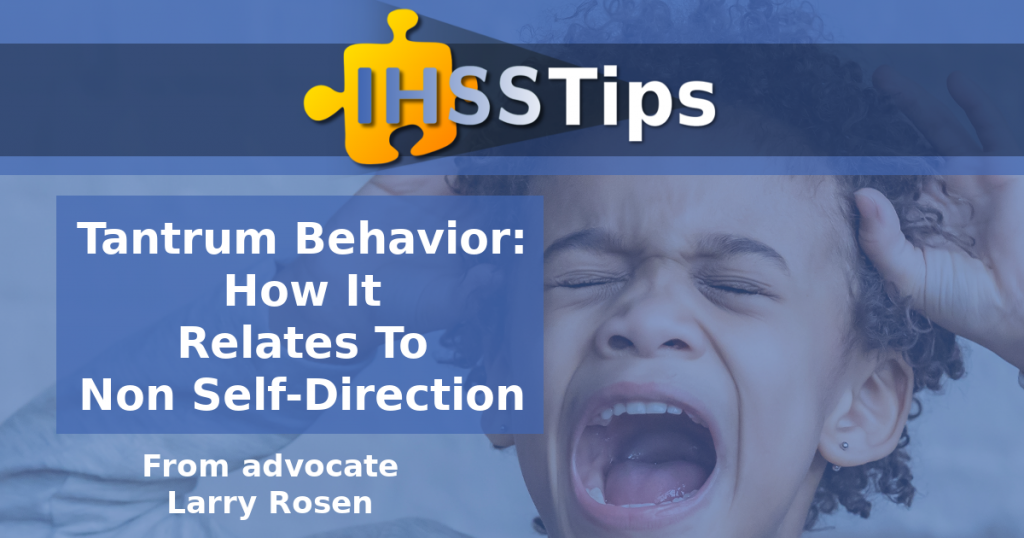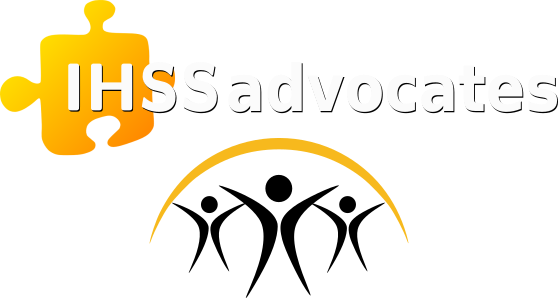Is Tantrum Behavior Self-Directing?
Share Via:
Video Transcription & Notes:
When I make the statement: “not all tantrum behavior is self-directed”, I referred to a California case law called Calderon vs Anderson. The CDSS (California Department of Social Services) provided examples of potentially self-injurious behavior for the superior court case back in 1996. I want to read the citation to you. They stated that,
“Some recipients are old, suffering degenerative diseases. Others are young but retarded, epileptic, blind, brain damaged or schizophrenic. The recipients cannot protect themselves from injury. Some are self-destructive. For example, one autistic, blind and brain-damaged child lapses into seizures and temper tantrums venting his frustrations by banging his head against a wall. Others cannot control normal but potentially hazardous activities such as cooking or smoking a cigarette.”
Not all tantrum behavior is self-directed
It’s clear the CDSS has identified that it is possible that tantrum behavior could be considered non self-directed behavior that’s worthy of protective supervision. Today we’re going to talk about tantrum behavior and how it relates to non self-direction.
Finding of Fact
For a tantrum to be excluded, there must be a finding of fact that the recipient knows that the specific tantrum related behavior may cause self-harm but does it anyway. For a recipient to be denied based solely on self-directed tantrum behavior, the additional finding of fact must also be made that a recipient knows that each tantrum, that rises to the level of self-injury, is potentially self-injurious. This standard is based upon the following CDSS policy which comes from All County Letter 15-25, and it states that:
“If a recipient displays self-injurious behavior that would qualify for Protective Supervision, but also displays excluded behavior(s) based on MPP § 30-757.172, they may still be eligible for Protective Supervision for the non-excluded behaviors.”
ACL 15-25
Where the conflict originates
It is possible for a recipient to exhibit both non self-directing and self-directed behavior and still be awarded protective supervision. The variable functioning and episodic behaviors are both topics that are memorialized in other CDSS policy and procedure. This is not a matter that hasn’t been discussed over and over again in other documents. Variable functioning is something that’s been discussed in notes from the training bureau and in both ACL 15-25 and ACL 17-95.
How to improve the likelihood that your child’s tantrum behaviors are correctly analyzed?
Today I’m going to give you the advice that each one of you who has ABA, and/or a behavioral intervention plan at school, should make it a point to either discuss with the supervisor (if ABA), or call for an emergency IEP meeting (if it’s school related) and have a clause placed in applicable documents. Even though the document may state something to the effect of, “The individual will engage in head-banging if denied access to preferred activity or item”. The social worker may then assume that the behavior is something that is self-directed. Because they are, in their opinion, trying to influence the outcome of somebody taking away something from them, or denying them access to something. Therefore, the social worker theorizes that because of the fact that the individual tries to head bang as a result of being denied that access, is trying to change the outcome of the situation. I, of course, find that to be absurd.
The reason why I find that to be absurd, is that this is the same individual that has an ABA, or an IEP, or behavioral implementation plan because of the fact they have a mental impairment. It’s kind of counter intuitive to believe that an individual who has a mental impairment has the ability to be able to premeditate such behavior in order to influence the outcome. I believe it’s more along the lines of rigid responses. If the child has a diagnosis of autism, it’s very possible that it’s part of the DSM-5 criteria. So it is my opinion that it’s not proactive, but reactive. It’s equivalent to what somebody might witness, say for example, at a funeral. I think everyone here would agree that nobody would believe that the purpose of someone crying or showing grief at a funeral is an attempt to resurrect the dead. That’s just a really silly belief.
However, when it comes to children with protective supervision and non self-direction, you have an individual who has a mental impairment who is severely impaired in judgment. This individual was found to be self-direction due to the language that was in the ABA report. The fact of the matter is, as previously stated, there needs to be a finding of fact that the behavior must be done with knowledge that the behavior is dangerous. Given that, that information is typically not discussed one way or the other in an ABA report in a behavioral implementation plan.
Add a clause or clarification in the document
My suggestion is to add it and make it a caveat, or make it some type of a clarification in the document. You can indicate something to the effect of,
“Nothing in this document shall be taken to indicate that this individual has the ability to assess danger and risk of harm. And that this individual, when they engage in head-banging as a result of being denied access to a preferred activity, is not doing so with the knowledge that headbanging is potentially dangerous”.
– Larry Rosen
In fact, they might want to indicate that there was a finding that the behavior is actually a result of the mental impairment defined by DSM-5 criteria. The extreme rigidity and the inability to transition between one activity to another is the reason why you have the reactions you have during those times.
There is nothing typical at all when somebody is transitioned from a preferred activity to a non-preferred activity and they head bang. Think about a typical child that does not have a mental impairment and they’re watching TV, and mom says, “Turn off the TV. It’s time to go to the store”. There is nothing typical if that individual, as result of having to turn off the TV, starts banging their head. It’s just not typical behavior. A typical child might tantrum, yes. And the tantrum might result in some resistance. Maybe some crying or arguing with the parents. But there is nothing inherently dangerous about arguing with your parents. There is nothing inherently dangerous about crying. Those are all what I would consider changing behaviors that follow the normal behaviors of a typical child.
- What makes it something that is worthy of protective supervision is when that grief escalates to a level of potential self-injury.
Must Have A Finding of Fact
Unfortunately I’ve seen that time and time again. I get position statements regularly where the county will actually make this part of their argument. They see that there is tantrum behavior discussed in either an ABA report, or they may see there is some type of tantrum behavior in a behavioral intervention plan from school. Therefore, the county takes up the position that that’s automatically a self-directed behavior. This is simply not true. In order for that to be self-directed behavior, there must be a corresponding finding of fact that the recipient understands that the actual behavior (head-banging) is something that could cause potential self-harm. I would say, that is absent in a majority of those cases that require ABA in the first place.
So, my advice for individuals who have ABA reports that have this type of language for individuals who have IEPs that have behavioral intervention plans, and you’ve been denied protective supervision because of the fact that somebody stated that the child is doing this as an attempt to achieve a desired results, would be to to go back to ABA, or go back to the school and get some type of revision put into the documents that specifically discusses that issue so there is no ambiguity about whether or not the child understands that this behavior is potentially self-injurious.
Include Clause in Separate Document
You could even get a separate document. I recommend that you make sure the separate document is on letterhead stationery, that it’s dated, and has a live signature on it. As advocates, these are the types of documents that we would seek if we had an issue with trying to argue whether or not a particular behavior was caused by being denied access to a preferred activity. With these types of documents we would try to establish that the recipient doesn’t understand that head-banging is potentially dangerous, and therefore, protective supervision is still warranted.
Inverted & Erroneous Clarification in ACL 17-95
This advocate (Larry Rosen) is calling on CDSS to rewrite All County Letter 17-95, as it contains language that is plainly erroneous and contradictory to other clarifications, regulations, statutes, and case law. The language found within ACL 17-95 provides inverted and erroneous clarification on two points. We would like CDSS to acknowledge that these points are problematic and can lead to absurd outcomes. We would like CDSS to rewrite the language pertaining to these points as the language is confusing. These are our concerns:
- An unspecified quantity of self-directing behavior does not result in instant termination of protective supervision. A sufficient quantity of evidence of non self-direction is what warrants the approval of protective supervision. Evidence of self-direction does not warrant the denial of protective supervision. In an insufficient quantity of evidence of non self-direction, would ultimately warrant the denial of protective supervision.
- Tantrum behavior cannot be excluded from protective supervision consideration unless a finding of fact is made as to whether all examples of potentially self-injurious tantrum behavior are intentional and executed with knowledge that they cause self-harm. This exclusion comes from CDSS policy and states that specific examples of potential self-injury may be excluded from protective supervision consideration when found to be intentional acts of self-destruction accompanied by the knowledge that this act may cause self-harm. However, CDSS policy also discusses the bifurcation, as we talked about before from 15-25, of such examples from those that lack such a finding of fact. Not all tantrums are automatically exclude-able.
Click here to see more IHSS videos by IHSSadvocates
Denied Protective Supervision?
Click the button below to get a free advocate evaluation of your child’s IHSS Protective Supervision case.

